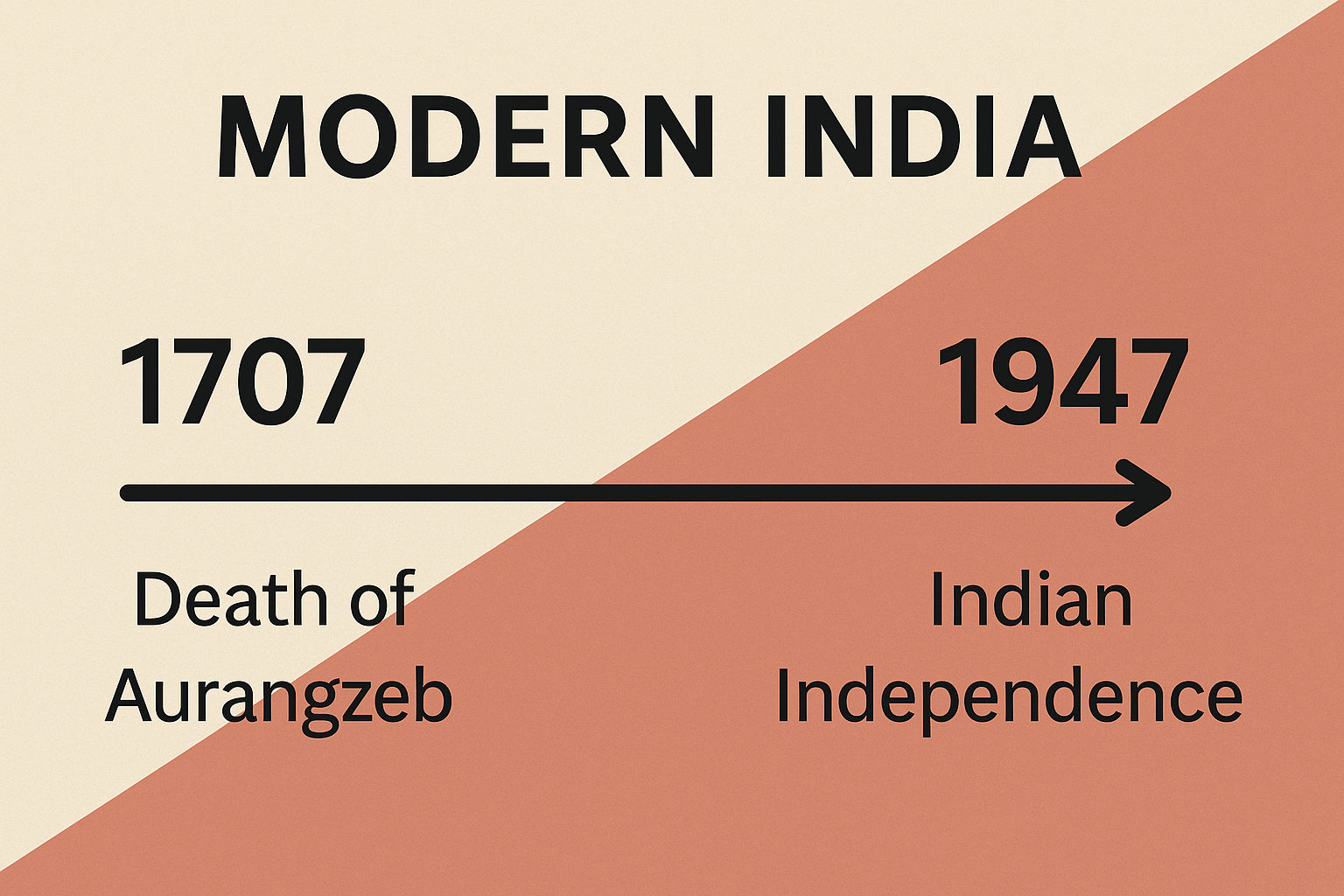🇮🇳 Gandhian Phase and Partition (1915–1947)
👶 Birth and Early Life of Mahatma Gandhi
- Full Name: Mohandas Karamchand Gandhi
- Born: 2nd October 1869, in Porbandar, Gujarat (then a princely state under British India)
- Family:
- Father: Karamchand Gandhi, Diwan (Prime Minister) of Porbandar
- Mother: Putlibai, deeply religious, influenced his moral values
- Marriage: Married to Kasturba Gandhi at age 13
- Education:
- Studied law in London (1888–1891)
- Became a barrister and returned to India to practice law in Bombay — but struggled to find success.
✈️ Why Gandhi Went to South Africa
- In 1893, Gandhi was offered a one-year contract by a Muslim merchant named Dada Abdulla to handle a legal case in Natal, South Africa.
- Gandhi accepted and left India — this journey turned into a 21-year stay (1893–1914).
🇿🇦 What Gandhi Did in South Africa
🛑 Faced Racial Discrimination:
- Thrown off a train at Pietermaritzburg for refusing to leave first-class despite holding a valid ticket.
- Barred from hotels, courtrooms, and public places.
- Experienced humiliation despite being a British subject.
💡 Awakening of Political Consciousness:
- Realized racial oppression was institutionalized.
- Decided to fight for the rights of Indians and non-Europeans.
📢 Major Contributions:
- Founded Natal Indian Congress (1894) – united Indian community.
- Developed concept of Satyagraha (1906) – non-violent resistance to injustice.
- Led campaigns against oppressive laws – like fingerprinting, registration, and poll taxes.
- Fought for civil rights of Indians and blacks.
🧠 Impact:
- Gained practical experience in organizing movements, negotiation, and public leadership.
- Sharpened his ideology: truth, non-violence, self-discipline, and civil disobedience.
🛬 Why Gandhi Returned to India
- Returned to India in January 1915, at age 45.
- He felt called to serve his own country.
- Advised by Gopal Krishna Gokhale to travel across India and study Indian conditions before entering politics.
- This marked the beginning of the Gandhian Phase of the Indian freedom struggle.
🔁 Context: Before Gandhi (1885–1915)
- Indian National Congress founded in 1885.
- Initial phase: Moderates (1885–1905): petitions, constitutional methods.
- Next phase: Extremists (1905–1919): Swadeshi, Boycott, assertive politics.
- Rising revolutionary nationalism and growing peasant unrest.
- But no mass movement with moral foundation — till Gandhi arrived.
🧳 Gandhi Returns to India – 1915
🎓 Background:
- Lived in South Africa for 21 years.
- Led successful Satyagraha against racial discrimination.
- Developed key principles:
- Satyagraha: Truth-force; non-violent resistance.
- Ahimsa: Non-violence as a way of life.
- Sarvodaya: Upliftment of all.
🇮🇳 Return to India:
- Arrived in Bombay in January 1915.
- Advised by Gopal Krishna Gokhale to observe and understand India first.
- Travelled across India for a year — saw:
- Rural poverty, indigo exploitation, oppression by planters, and colonial injustice.
🌾 Early Satyagrahas (1917–1918)
1. Champaran Satyagraha (1917) – Bihar
- First Satyagraha in India.
- Against tinkathia system (forced indigo farming by British planters).
- Gandhi investigated grievances; used non-violent civil disobedience.
- Result: Tinkathia system abolished, victory for peasants.
2. Ahmedabad Mill Strike (1918) – Gujarat
- Workers demanded plague bonus from mill owners.
- Gandhi used fast unto death as a tool of pressure.
- Result: Compromise achieved, set example for labor negotiations.
3. Kheda Satyagraha (1918) – Gujarat
- Crop failure, yet government demanded full tax.
- Gandhi led peasants in refusing to pay.
- Result: Revenue relaxed, farmers gained confidence.
🚩 Major Mass Movements Led by Gandhi
✊ Non-Cooperation Movement (1920)
📜 Background:
- Launched in response to:
- Rowlatt Act (1919) – allowed detention without trial
- Jallianwala Bagh Massacre (1919) – brutal repression of peaceful protesters
- Khilafat Movement – Muslim demand to preserve the Caliph
- Failure of 1919 Act – diarchy seen as a sham reform
🧠 Gandhiji’s Strategy:
- Promote non-violent non-cooperation with British rule:
- Boycott of foreign goods, titles, elections, schools, courts
- Promotion of Swadeshi, Khadi, and national education
- Encourage resignation from British institutions
🔥 Impact:
- First mass-based, nationwide movement led by Gandhiji
- Brought Hindus and Muslims together (Khilafat + Swaraj)
- Created political awakening among rural masses
🛑 Ended:
- February 1922, after Chauri Chaura incident (violent mob killed 22 policemen)
- Gandhiji called off the movement to preserve non-violence
✊ Civil Disobedience Movement (1930–34)
- Launched by Gandhiji with the Dandi Salt March on 12 March 1930.
- Marked a nationwide non-violent defiance of colonial laws:
- Breaking Salt Law
- Boycott of British goods, taxes, and schools
- Mass resignations and protests
🤝 Gandhi–Irwin Pact (1931):
- British Agreed: Release political prisoners, lift restrictions, allow peaceful protests, Permit use of salt by coastal people.
- Gandhiji Agreed: Suspend movement and attend RTC II.
⚠️ But: Talks in London failed → movement resumed in 1932
🛑 Withdrawn in 1934 due to:
- Harsh British repression
- Internal disunity (e.g., Poona Pact issue)
- Failure of Round Table talks
- Focus shift to constructive work and Harijan upliftment
🧠 UPSC Mains Insight:
“The Simon Commission, Round Table Conferences, and Civil Disobedience Movement represent the cycle of protest, negotiation, and renewed resistance. Together, they highlighted British reluctance to share real power and shaped India’s constitutional path leading to the Government of India Act, 1935.”
🧂 What Was the Salt Law?
The Salt Law was a British colonial law that gave the government a monopoly over the manufacture and sale of salt in India. Indians were forbidden to produce or sell salt independently, and had to buy heavily taxed salt from the British.
⚖️ Key Features:
- Making salt from sea or natural sources was illegal without a government license.
- Even poor Indians living near the sea could not collect salt.
- The salt was taxed — a burden that hit the poorest the hardest.
🧠 Why Did Gandhiji Choose Salt?
- Symbolic: Salt is essential to life, used by all — rich or poor, Hindu or Muslim.
- Universal: Affected every Indian household.
- Simple but powerful: Breaking the Salt Law was non-violent, yet directly challenged British authority.
🏁 Role in Civil Disobedience Movement:
- On 12 March 1930, Gandhiji launched the Dandi March to protest the Salt Law.
- Walked 240 km from Sabarmati to Dandi, making salt from seawater.
- Sparked mass civil disobedience across the country, as thousands broke the law.
🧠 UPSC Mains Insight:
“The Salt Law symbolized the unjust colonial control over basic necessities. By targeting it, Gandhiji turned everyday suffering into political resistance, transforming salt into a weapon of mass civil awakening.”
✊ Quit India Movement – August 8, 1942
- Launched by Gandhiji with the slogan “Do or Die”
- Demanded immediate British withdrawal
- All major Congress leaders were arrested overnight
- Sparked a spontaneous mass uprising:
- Strikes, boycotts, sabotage of railways and telegraphs
- Brutally suppressed by the British
- However, it showed that British rule no longer had legitimacy


One Comment